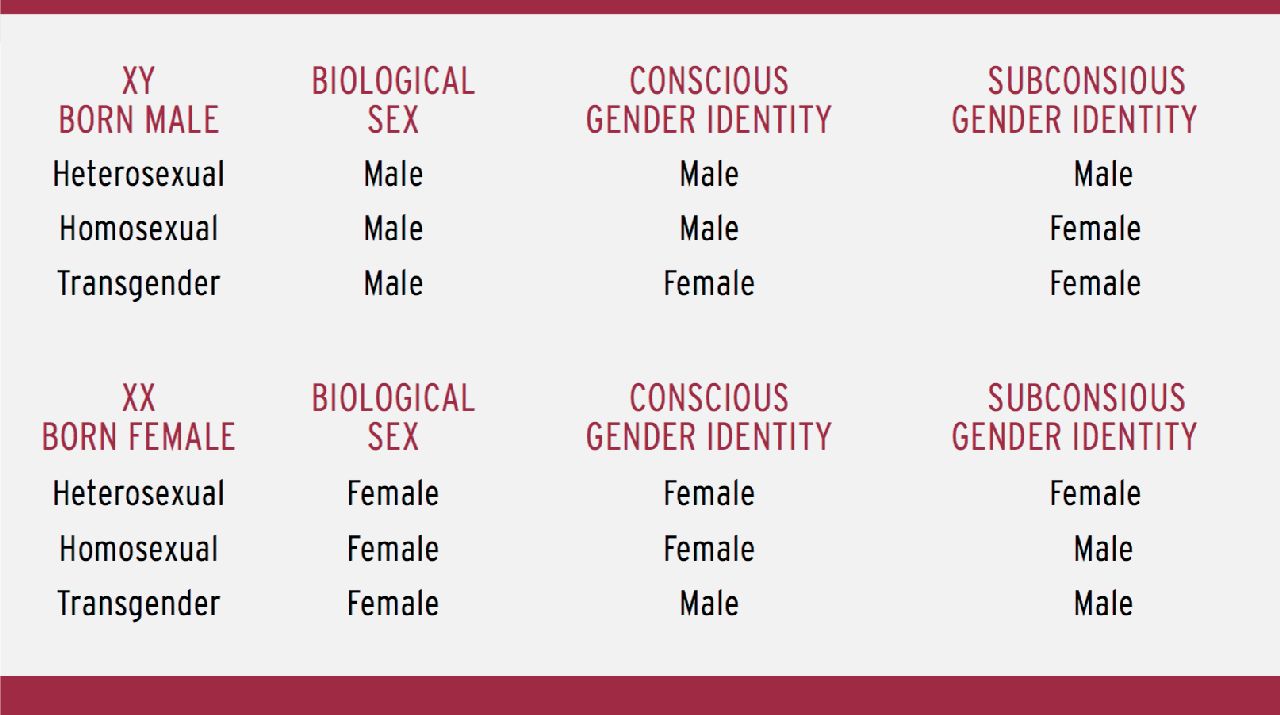Imagine a woman telling you, “I’m transgender. Please call me Michael.” It’s obvious she’s female, but she’s asking you to call her by a man’s name. What do you do?
Many people today reject the notion that gender is a fixed trait based on biology. Rather, they believe gender is a flexible trait based on society. As feminist and social theorist Simone de Beauvoir wrote, “One is not born, but rather becomes, woman.”1 Anatomy, therefore, is not destiny. One can choose what gender one wants to be.
Though this sounds counterintuitive, the culture is buying it. They are sympathetic to the plight of transgender people. They believe “Michael” is a man trapped in a woman’s body and they’re willing to accommodate the transgender perception.
Recently, a woman complained to the management of a fitness gym after she was startled to see a man in the women’s locker room. The public relations department responded by saying, “Guests may use all gym facilities based on their sincere self-reported gender identity.”2 In other words, if you’re a man but believe you’re a woman, you can use the women’s locker room. Concerned by the gym’s policy, the woman warned other women at the gym about the transgender person. Management asked her to stop. When she refused, the gym cancelled her membership.
It’s not surprising, then, that Time Magazine called transgender the next civil rights movement.3 They predict a cultural shift as significant as that toward African-Americans and (though not parallel) homosexuals.
Christians, then, face another great challenge. The culture thinks they’re backward-thinking on moral issues, bigoted about homosexuality, and probably biased against transgender people. How do we respond?
We need to move forward with truth and grace, the way Jesus did. This requires becoming a new kind of apologist. We can’t simply quote what Scripture says because most of our culture rejects biblical authority. Instead, science is king in today’s world. Apologists need to be savvy enough to know the truth revealed in Scripture (special revelation) and in science (general revelation). Both sources of knowledge come from God and, as a result, conform to each other.
As you learn the truth about transgender people from both Scripture and science, it will help you have compassion for them. Jesus knew that those around Him were lost and hurting. That’s what led Him to act with kindness and good will towards them.
Following in the footsteps of Christ, the new kind of apologist integrates both truth and compassion in his response. Knowing truth requires knowing what Scripture says, what science says, and understanding the experience of transgender people. If we are steeped in this truth, it will change the way we feel about transgender people and it will change the way we treat them.
Know the Truth
Although Scripture is largely silent about transgender, it does speak directly to the broader question of the created order, gender, and sexual behavior. It turns out we have a biblical grounding for the gender roles we intuitively know to be true.
In the beginning, God followed a pattern of creating and separating. He created the universe and separated the heavens from the earth. He created the light and separated it from the night. He created the waters and separated it from the ground. He created creatures and separated humans from animals.
When God made humanity, He made two sexes: male and female. Though separate, they come together to create something more whole than by themselves. That’s why God ordained a man to leave his parents and join his wife in a one-flesh union (Gen. 2:24). By following the gender role that correlates with your biological sex, a man and a woman can begin a family, the fundamental unit of society.
There’s no scriptural indication that a person’s perceived gender should differ from his biological sex. Anatomy is intended to denote gender identity.
Though gender complementarity is explicitly taught in Scripture, it is also evident from science. Even a non-Christian is hard-pressed to deny the obvious anatomical and physiological reality. Men and women are, by virtue of their anatomy, physiological complements to one another. The male and female sex organs not only fit together, they function together. Their shape, size, fluids, tissue type—everything about their anatomy and physiology—tells us they are made to work together. Simply put, men and women are fashioned by God for each other.
What evidence do we have that humans are made for heterosexual sex? When a couple engages in a conjugal act, they can create another human being. In fact, the sex organ is the only body part that requires another human being of the opposite sex to fulfill its ultimate function. Sperm and egg never actualize their full potential until they unite. The only way that’s possible is through male-female sex. Biology and gender identity go together. Male-female complementarity is the only way humans can achieve their reproductive purpose.
What Is Transgender?
In order to understand the transgender person, it’s critical to understand the relationship between biology and gender identity. Your biological sex is a physical trait that’s determined at conception. Gender identity is a nonphysical trait that develops from birth through young adulthood. It’s the part of your personality that contains your beliefs about whether you are male or female. A person has both a conscious and subconscious gender identity.
In most cases, your gender identity follows your biological sex. A boy usually develops a conscious and a subconscious male gender identity. A girl usually develops a female gender identity. When gender identity matches biology, this results in heterosexuality.
It is possible, though, for a person to develop a gender identity that is different from his or her biological sex. Male homosexuals have a conscious gender identity that’s male, but most (though not all) have a subconscious gender identity that’s female.
A transgender man has a female subconscious gender identity too, similar to a homosexual, but also consciously thinks of himself as female. That’s why (unlike a homosexual man) he might say he feels like a woman trapped in a man’s body. The converse would be true with a female transgender person. The reality is more nuanced than this, but these charts summarize this concept.

Transgender people feel like they are trapped inside a body that is the opposite of their perceived gender. As you can imagine, this leads to a tremendous amount of psychological and emotional distress. Many of them are also stigmatized by society. Sadly, 41 percent of transgender people attempt suicide (compared to 1.6 percent of the general population).4
They are deeply hurting inside. That’s why many of them attempt to change their bodies with hormones, drugs, and sex-change surgery. Instead of working to change their gender identity to match their biology, they want to change their biology to match their gender identity. An obvious concern with the latter approach is that while it’s not possible to mistake your biological sex, it is possible to mistake your perceived gender.
The notable exception is someone who is born intersex (formerly called hermaphrodite). They have malformed or sexually ambiguous genitals, and it’s not immediately clear whether they are male or female. Doctors encourage the parents to decide on a gender, with their counsel, but it’s possible the choice they make leads to gender confusion in later life.
For example, a genetically male child can be born with a severe phallic defect. The doctors surgically resect what’s left of the male sex organs and attempt to make his genitals look more female. The doctors and parents hope that by raising the child as a girl, the child will become one.
This approach assumes that gender is wholly a social construction. You can’t make a girl, though, by altering a boy’s body, infusing him with female hormones, and treating him like a girl. Genetically male children who are born intersex still have a Y chromosome that drives their development into a male child. They also lack ovaries and the accompanying female hormones.
One study followed boys who were “reassigned” as girls shortly after birth. Years later, they all engaged in male-typical behaviors including aggressiveness, rough-and-tumble play, and sexual arousal by females. Despite being surgically, socially, and legally reassigned as females, the fact is they were still boys. Most of them who learned later in life that they were genetically male wished to become men again.5 Why? Because gender is not merely a social construct, but innately tied to one’s biological sex.
Transgender adults who get sex-change operations (transsexuals) fare no better. Although some will say they are content with their new gender, most still have the same emotional and psychological problems they had prior to surgery.6 Dr. Paul McHugh, former director of the department of psychiatry at Johns Hopkins Hospital, candidly regrets his institution’s complicity with sex-change surgeries. He believes, as the field of medicine has known for a century, that being transgender is not a healthy state. “We psychiatrists...would do better to concentrate on trying to fix their minds and not their genitalia,” he writes. “We have wasted scientific and technical resources and damaged our professional credibility by collaborating with madness rather than trying to study, cure, and ultimately prevent it.”7
Though Dr. McHugh and others recognize the problem with transgender people is not with their bodies, but with their minds, many health professionals still don’t. According to modern medicine, it’s inaccurate (and politically incorrect) to say something is wrong with a transgender person. Therefore, their psychological problems are left untreated. They think sex reassignment surgery will solve their psychological problems, but they are mystified when their symptoms persist.
That’s why many transsexuals regret their surgeries.8 They have irreversibly changed their bodies, yet their psychological distress is not relieved. This is an indication that the transgender impulse and subsequent surgery are mistakes. That, however, doesn’t fit the cultural narrative that you are whatever gender you believe yourself to be. The LGBT community that once supported those who have transition surgery no longer accepts those who regret it. They vilify and intimidate transsexuals who speak out and warn others.9 So, whether the person becomes transsexual by surgically changing their sex, or does not have surgery and stays transgender, either way they still remain broken and hurt, longing for hope and healing.
As a result, many transgender people believe they will secure some comfort by behaving according to their perceived gender. To secure that end, our culture is now demanding we allow transgender people access to bathrooms, locker rooms, and changing rooms that correspond to their perceived gender identity. If a man identifies as a woman, for example, he should be allowed to use a women’s facility. Let me offer three quick thoughts about this idea.
First, every public policy should consider both its immediate and secondary effect. Allowing a biological male who perceives he’s female to use a women’s facility has the immediate effect of providing satisfaction to a transgender individual. The problem, though, is the secondary effect, which allows men with malicious intent to exploit this policy. They can disrobe in the presence of women and girls who are also disrobing or simply gain access to locations where females undress. In other words, this policy jeopardizes the safety of women and children. We should find a solution that considers everyone’s best interest, not just a minority’s.
Second, we need to lower our expectations, but not our standards. We shouldn’t be surprised when the world denies common-sense notions like the belief that men shouldn’t be allowed in women’s facilities. People are blind to the truth and are driven by politically correct ideologies. If we expect or hope that secular culture will make sound decisions, we’ll often be disappointed.
Although lowering our expectations can prepare us for this fallen world, we should not lower our standards. Never compromise biblical truth to go along with cultural trends. The Bible is clear that God created man and woman and made them to be sexual complements to each other. No matter the pressure to deny this simple truth, we should remain faithful to what God says.
Third, do what is necessary to protect yourself and your family. If you feel unsafe about using a bathroom or changing room, then avoid it. Use good judgment and common sense. Don’t be pressured into making an unwise decision in order to go along with the culture or accommodate the world’s values.
Remember, the enemies are the ideas of the world, not transgender people who need compassion.
Treat Them with Compassion
The new kind of apologist who is aware of the transgender person’s brokenness finds that this knowledge changes the way he responds. He’s touched by compassion for transgender people, and his kindness towards them tempers his apologetic approach.10 If not, what he says will not matter or, worse, will come off callous and harsh.
The truth and compassion approach is the one Jesus, the perfect apologist, took. He understood people better than anyone else. His knowledge was perfect and, consequently, His compassion flowed freely.
The truth we’ve learned about transgender people is a sober reminder that we live in a fallen world. These people have been hurt. The culture has lied to them and medical professionals have been complicit in their gender-identity confusion. We need to speak truth to them, but it must be motivated by compassion. Here’s what we can do.
First, make your relationship with transgender people a top priority. It doesn’t have to be the top priority, but put it high on the list. Relationships are the bridge we use to communicate with each other, especially about things that are difficult to say. Your ability to speak the truth in love will be a function of your relationship with them. By knowing them personally, you’ll discover their unique situation. This should evoke the compassion so you can speak with precision and care. Therefore, build your friendship first and make your arguments second.
If you’re not close to them, consider that you might not be the right person to speak frankly about their life. This chapter began with a hypothetical conversation with a transgender person, a woman whose gender identity is male. How would you respond if she asks you to call her Michael? The answer depends on your relationship with her. If you’re a friend or family member, then speak the truth with compassion. If she is a casual acquaintance or you just met, speaking truth will seem presumptive or out of place. It might be better to choose the language she prefers so you don’t come across mean-spirited.
Second, Christian family rules apply only to those inside the Christian family.11 It’s possible you have a transgender friend who claims to be Christian. Scripture calls them to live according to the commands of Christ. It also authorizes believers to oversee each other’s behavior to see if it lines up with the biblical standard (1 Cor. 5:12–13). That means your relationship with them should be similar to relationships with other Christians. You’re not making special rules for your transgender friend. You’re holding all people who identify as Christian to the same Christ-like standard. In this case, their pursuit of a transgender identity rejects their God-given identity. Your prayer and goal is to “restore such a one in a spirit of gentleness” (Gal. 6:1–2 nasb). You would expect them to do the same for you. That’s because Christian friends spur one another on toward godly living (Heb. 10:24).
On the other hand, if your transgender friend doesn’t claim to be a Christian, family rules don’t apply. We can’t expect non-Christians to live like Christians. Of course we want transgender people to recognize their perceived gender is not correct. We also want them to make safe choices. That means we should set proper expectations for ourselves about them. Even though we might ask someone to change how they live because we know their lives will be better in the long run, we have to realize they are not motivated to act according to God’s commands. If we want them to live like Christ, they need Christ to live in them first.
Third, focus on the Gospel. Though apologists can craft clever arguments in defense of their views, a wise Christian recognizes that apologetics is a means to an end and not an end in itself. My initial motivation with a nonbeliever is to present the Gospel of Jesus—an offer of pardon for their crimes against God. Only when they reject it or want clarification do I offer an apologetic response.
That’s the approach I take with everyone: a Muslim, an atheist, a homosexual, or a transgender. In most cases where a nonbeliever has changed how he lived, it was because he first committed his life to Christ. Then the Holy Spirit transformed him from the inside out. The Spirit changed his heart and his desires, and then changed his life. As the saying goes, God catches His fish first, and then He cleans them. We want our transgender friend or family member to turn to God first. Then, the other changes come more easily over time.
Transformed
Transgender people are beguiled by a false belief. They don’t think their biology determines their gender. The culture is complicit in this deception. Like the emperor’s new clothes, the truth is obvious, but few people are willing to point it out.
The challenge transgender people face is not with their bodies. That’s why a physical solution will not be able to resolve their problem. Their only hope for lasting satisfaction and peace is not by mutilating perfectly healthy bodies, but a transformation of their broken souls. Only the Great Physician can do that.
[This article is excerpted from A New Kind of Apologist, edited by Sean McDowell.]

